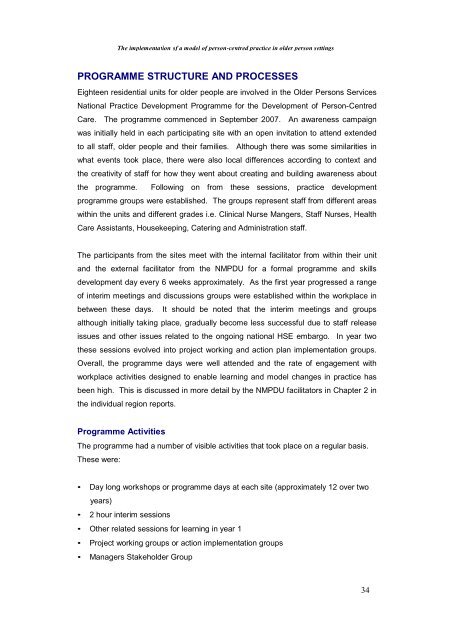The Implementation of a Model of Person-Centred Practice In Older ...
The Implementation of a Model of Person-Centred Practice In Older ...
The Implementation of a Model of Person-Centred Practice In Older ...
Create successful ePaper yourself
Turn your PDF publications into a flip-book with our unique Google optimized e-Paper software.
<strong>The</strong> implementation <strong>of</strong> a model <strong>of</strong> person-centred practice in older person settings<br />
PROGRAMME STRUCTURE AND PROCESSES<br />
Eighteen residential units for older people are involved in the <strong>Older</strong> <strong>Person</strong>s Services<br />
National <strong>Practice</strong> Development Programme for the Development <strong>of</strong> <strong>Person</strong>-<strong>Centred</strong><br />
Care. <strong>The</strong> programme commenced in September 2007. An awareness campaign<br />
was initially held in each participating site with an open invitation to attend extended<br />
to all staff, older people and their families. Although there was some similarities in<br />
what events took place, there were also local differences according to context and<br />
the creativity <strong>of</strong> staff for how they went about creating and building awareness about<br />
the programme. Following on from these sessions, practice development<br />
programme groups were established. <strong>The</strong> groups represent staff from different areas<br />
within the units and different grades i.e. Clinical Nurse Mangers, Staff Nurses, Health<br />
Care Assistants, Housekeeping, Catering and Administration staff.<br />
<strong>The</strong> participants from the sites meet with the internal facilitator from within their unit<br />
and the external facilitator from the NMPDU for a formal programme and skills<br />
development day every 6 weeks approximately. As the first year progressed a range<br />
<strong>of</strong> interim meetings and discussions groups were established within the workplace in<br />
between these days. It should be noted that the interim meetings and groups<br />
although initially taking place, gradually become less successful due to staff release<br />
issues and other issues related to the ongoing national HSE embargo. <strong>In</strong> year two<br />
these sessions evolved into project working and action plan implementation groups.<br />
Overall, the programme days were well attended and the rate <strong>of</strong> engagement with<br />
workplace activities designed to enable learning and model changes in practice has<br />
been high. This is discussed in more detail by the NMPDU facilitators in Chapter 2 in<br />
the individual region reports.<br />
Programme Activities<br />
<strong>The</strong> programme had a number <strong>of</strong> visible activities that took place on a regular basis.<br />
<strong>The</strong>se were:<br />
• Day long workshops or programme days at each site (approximately 12 over two<br />
years)<br />
• 2 hour interim sessions<br />
• Other related sessions for learning in year 1<br />
• Project working groups or action implementation groups<br />
• Managers Stakeholder Group<br />
34
















